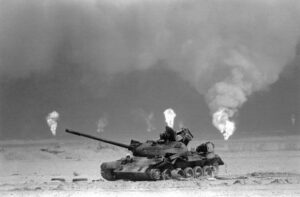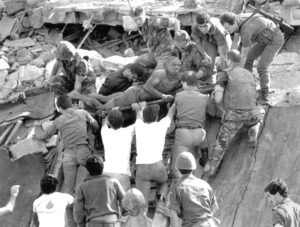Pat Sloyan
- 2000

Fellowship Title:
- Manipulation of the Media During Military Conflict
Fellowship Year:
- 2000

What Bodies?
Leon Daniel, as did others who reported from Vietnam during the 1960s, knew about war and death. So he was puzzled by the lack of corpses at the tip of the Neutral Zone between Saudi Arabia and Iraq on Feb. 25, 1991. Clearly there had been plenty of killing. The 1st Infantry Division (Mechanized) had smashed through the defensive front-line of Saddam Hussein’s army the day before, Feb. 24, the opening of the Desert Storm ground war to retake Kuwait. Daniel, representing United Press International, was part of a press pool held back from witnessing the assault on 8,000 Iraqi defenders. “They wouldn’t let us see anything,” said Daniel, who had seen about everything as a combat correspondent. A destroyed Iraqi tank rests near a series of oil well fires during the Gulf War on March 9, 1991 in northern Kuwait. Hundreds of fires burned out of control, casting a pall of toxic smoke over the Emirate and raising health and environmental concerns. (AP Photo/David Longstreath) The artillery barrage alone was enough to cause a

Look Over Here
Few American presidents projected the image of Commander-In-Chief more than Ronald Reagan. He snapped salutes at Marine honor guards around the White House with the skill of a Washington, Grant or Eisenhower. While those presidents learned on the battlefield, Reagan was trained by playing all kinds of military men. He battled the Sioux in, “They Died With Their Boots On,” the Nazis in, “Desperate Journey,” and the Nips in, “Flying Leathernecks.” The movie uniforms were as impeccable as his swagger. Of course, he spent World War II in the safety of Hollywood backlots. “Poor eyesight,” he explained later. But while on center stage at the White House, the Reagan military greeting to the Marine sergeant in dress blues at the steps of Marine One, the president’s helicopter was a fixture in the American mind. The crooked grin with the slightly cupped hand to the right eyebrow marked an aging veteran who doted on the young men and women serving the nation. It was woven into an image that helped Americans feel good about him, themselves
Masking the Face of Battle
(Curator’s Note: Photographs for this story were copyrighted and not available for electronic publishing.) Overlooked in 20th century war-making is that blatantly corrupt leader of a Balkan backwater who blazed a trail that faltering democratic leaders would follow in reviving domestic political fortunes on foreign battlefields. I speak of Rufus T. Firefly, installed as president of Freedonia on his promise to transfuse the nation’s resources into his personal bank account. “Just wait ‘til I get through with it,’’ Firefly said on taking office. Firefly’s contribution has been overlooked because of the ridicule of his record in the 1933 film, “Duck Soup.’’ Firefly will forever be considered something of a laff riot since the casting of Groucho Marx as the tiny country’s leader. But the film accurately preserves that moment when the blood lust seeps into the veins of a nation ready to launch an attack on enemies real or imagined. It is the Grand Ballroom scene with Groucho, Harpo, Chico and Zeppo, joining the multitude and a heavenly choir in, “We’re Going To War.” Bottling
